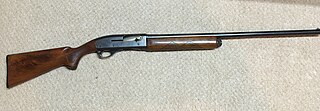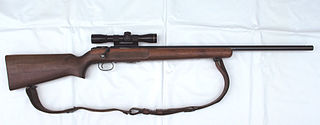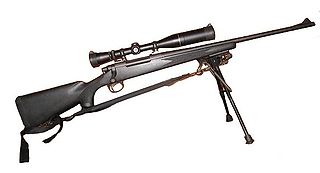 W
WThe M24 Sniper Weapon System (SWS) is the military and police version of the Remington Model 700 rifle, M24 being the model name assigned by the United States Army after adoption as their standard sniper rifle in 1988. The M24 is referred to as a "weapon system" because it consists of not only a rifle, but also a detachable telescopic sight and other accessories.
 W
WThe Remington 1911 R1 is a semi-automatic pistol modeled after the classic Colt 1911 which has served the US armed forces for over 100 years. Like the Colt 1911, the Remington 1911 is single action only, and has a grip safety and a manually operated thumb safety; it also has a Colt Series 80 style firing pin safety.
 W
WThe Adaptive Combat Rifle (ACR) is a modular assault rifle designed by Magpul Industries of Austin, Texas, and known initially as the Masada.
 W
WThe Remington Model 10 is a pump-action shotgun designed by John Pedersen for Remington Arms. It has an internal striker within the bolt and a tube magazine which loaded and ejected from a port in the bottom of the receiver. An updated version, the Model 29, was introduced in 1930 with improvements made by C.C. Loomis.
 W
WThe Remington Model 11-48 is a semi-automatic shotgun manufactured by Remington Arms as the first of its "new generation" semi-automatics produced after World War II. Released as the replacement for the Remington Model 11, it was manufactured from 1949 to 1968 and was produced in 12, 16, 20 and 28 gauge and .410 variations.
 W
WThe Remington Model 34 is a bolt-action rifle that was manufactured by Remington Arms from 1932 until 1935.
 W
WThe Remington Model 51 is a small pocket pistol designed by John Pedersen and manufactured by Remington Arms in the early 20th century for the American civilian market. Remington manufactured approximately 65,000 Model 51 pistols in .32 ACP and .380 ACP calibers from 1918 to 1926, though small numbers were assembled into the mid-1930s.
 W
WThe Remington Model 95 is a double-barrel pocket pistol commonly recognized as a deringer. The design was little changed during a production run of nearly 70 years through several financial reorganizations of the manufacturer causing repeating serial number sequences. Guns were offered with engraving or plain blued or nickel-plated finish with grips of metal, walnut, rosewood, hard rubber, ivory or pearl.
 W
WThe Remington Model 511 Scoremaster is a bolt-action rifle manufactured by Remington Arms from 1939 until 1963. The Model 511 has a 25-inch (64 cm) barrel, a one-piece hardwood stock, and a blued metal finish.
 W
WThe Remington Model 512 Sportmaster is a bolt-action rifle manufactured by Remington Arms. The Model 512 has a 25-inch (64 cm) barrel, a one-piece hardwood stock, and a blued metal finish. An unusual feature of this rifle is that it uses a tubular magazine in conjunction with a bolt action. Most modern tube-fed firearms typically use a lever action or a pump action, but in the middle of the 20th century, many bolt-action .22's used tubular magazines as the high-capacity magazine of the era.
 W
WThe Remington Model 513 Matchmaster is a bolt-action rifle, manufactured from 1940 to 1968. Since the rifle was designed for target shooting, it came equipped with a sturdy half stock with sling swivels, a beavertail fore end, and a straight comb which rose at the heel. Matchmaster barrels were a 27" heavy target semi-floating type. The patented Matchmaster trigger mechanism had an adjustable stop. The Matchmaster was made to fire only the .22-caliber Long Rifle cartridge from a detachable magazine. Civilian versions of the Matchmaster have a blued finish, while those made for U.S. Army and ROTC service can have either a blued or a parkerized finish.
 W
WThe Remington Model 521 TL Junior is a member of the Remington 500 series rifles. It is bolt action with a walnut stock and a 24 in (61 cm) barrel. It has a Lyman aperture rear sight that is adjustable for elevation and windage. The rifle takes a six-round magazine that fits flush with the bottom of the rifle.
 W
WThe Remington Model 700 is a series of bolt-action centerfire rifles manufactured by Remington Arms since 1962. It is a development of the Remington 721 and 722 series of rifles, which were introduced in 1948. The M24 and M40 military sniper rifles, used by the US Army and USMC, respectively, are both based on the Model 700 design.
 W
WThe Remington Model 7400 is a series of semi-automatic rifles manufactured by Remington Arms. The Model 7400 was a replacement of the Model 740 rifle which Remington produced from 1952 to 1981. The 7400 model was ultimately replaced by the Model 750 in 2006.
 W
WThe Remington Naval Model 1865 is pistol designed by Joseph Rider and manufactured by Remington Arms since 1866 in .50 caliber.
 W
WR5 RGP is a carbine that was designed and manufactured by Remington Arms. It is one of many AR-15 type rifles which uses a gas piston operating system in an attempt to improve the reliability of the weapon.
 W
WThe Remington R51 is a semi-automatic pistol announced in late 2013 and was available to the market in January 2014. The R51 is a modernized version of the John Pedersen-designed Remington Model 51 pistol now chambered in 9×19mm caliber. Remington announced plans to offer the pistol in .40 S&W and other calibers. However, no other chamberings were offered by the time of Remington's bankruptcy in 2018.
 W
WThe Remington-Rider Single Shot Derringer Parlor Pistol was made by E. Remington and Sons between 1860 and 1863. Only two hundred were produced.
 W
WRemington Rolling Block is a family of breech-loading rifles that was produced from the mid-1860s into the early 20th century by E. Remington and Sons. The action was extremely strong, and could easily withstand the increased pressure of the new smokeless powders coming into use by the late 1880s.
 W
WThe Remington XP-100 is a bolt-action pistol produced by Remington Arms from 1963 to 1998. The XP-100 was one of the first handguns designed for long-range shooting, and introduced the .221 Fireball and 6×45mm. The XP-100 was noted for its accuracy and is still viewed as competitive today in the sport of handgun varminting, which it helped create, as well as in metallic silhouette shooting.
 W
WThe Remington Zig-Zag Derringer - or "Pepper Box", originally termed "Elliot's Pocket Revolver", was made 1861-1862 with fewer than 1,000 manufactured.
 W
WThe Remington–Keene is an early bolt-action rifle with a tubular magazine.
 W
WThe M2010 Enhanced Sniper Rifle (ESR), formerly known as the XM2010 and M24 Reconfigured Sniper Weapon System, is a sniper rifle developed by PEO Soldier for the United States Army. It is derived from and replaced the M24 Sniper Weapon System, and was designed to give snipers longer range in the mountainous and desert terrain of the War in Afghanistan. After winning a competitive bidding process, Remington was awarded the production contract for up to 3,600 weapons. The Army had anticipated sending the upgraded weapons to deployed snipers in late 2010, but later expected fielding would happen in January 2011. The M2010 fires .300 Winchester Magnum (7.62×67mm) ammunition, which offers about 50 percent more effective range than the M24's 7.62×51mm NATO. This chambering to dimensionally larger cartridges is possible because the M24 was designed to use the "long action" bolt version of the Remington 700 receiver for cartridges up to 3.34 inches (84.84 mm) in overall length.